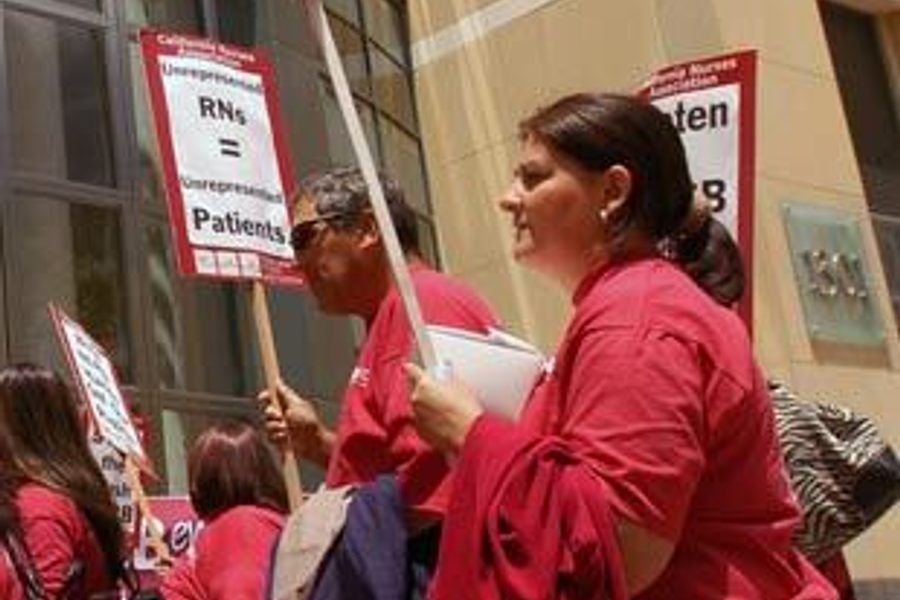Nurses Fight to Retain Right to Unionize
An NLRB ruling undercut the rights of millions to unionize by reclassifying them as supervisors.
David Moberg

When an organizer first talked to Kathy Haff three summers ago about joining a union, the veteran cardiac nurse at Chicago’s Our Lady of Resurrection Hospital wanted to sign up immediately. “I wanted to improve our staffing, which is lousy,” Haff says, complaining that the hospital managers assign too few nurses to care properly for the patients. “With a union, we’d have some say in what’s going on. Often they change things without even asking us or running it by us to see if it’s a good idea.”
But this summer, if the National Labor Relations Board (NLRB) rules as many labor lawyers expect, Haff may be denied her rights under federal labor law to join a union. This is because Haff, like many registered nurses in hospitals, occasionally works as a “charge nurse” in addition to her regular nursing work, filling out paperwork, making sure there will be enough nurses for the next shift and dealing with patients’ families. The NLRB is expected to rule that such duties make her a “supervisor,” thus revoking her right to act collectively at work and join a union.
It’s a cruel irony for Haff to be denied a voice at work in crucial matters about patient care on the grounds that she’s already part of management. “I can’t do any hiring or firing or make any decisions,” she says. “I don’t have any real authority.”
This seemingly arcane question of who is a supervisor could lead to 300,000 nurses losing the right to be in the unions to which they already belong, and could stymie ambitious plans to organize nearly 2 million more nurses. Although many unions have tried to organize nurses, over the past two decades they have only managed to keep pace with the growth of the profession, which remains about 16 percent unionized. Nearly all hospitals, even religious and nonprofit institutions, fight unionization relentlessly unless unions succeed in pressuring them to adopt a neutral stance.
The feared ruling by the NLRB could lead to the loss of the right to a union for millions of other workers, according to AFL-CIO organizing director Stewart Acuff, including many foremen in the construction industry, along with team leaders at factories, mines and docks. And AFL-CIO Department of Professional Employees president Paul Almeida argues that a large number of engineers and technical workers could be denied their rights to unionize at a time when prospects for their organizing have improved. “There are a lot of people in engineering and other professions who perform a similar role [to a charge nurse], do it sporadically, like a lead on a particular project,” he says.
The Economic Policy Institute, a Washington think tank, calculates that pending NLRB cases could affect 1.4 million workers, and if the board uniformly adopts a broad interpretation of what it means to be a supervisor, 8 million more workers would lose their right to unionize.
The ruling “potentially has a very broad effect,” says former NLRB chief counsel Fred Feinstein, because the structure of the typical workplace has become much more fluid and less clearly hierarchical since Congress first enacted the basic federal labor law in 1935. Originally, supervisors could be in unions, but in 1947 pro-business legislators pushed through the Taft-Hartley Act, which excluded them. Since then, judges and legislators have repeatedly said that workers in ambiguous positions where they were mainly exercising their professional skills in leadership roles should be eligible to form unions.
However, in 1980, the Supreme Court ruled in NLRB v. Yeshiva University that tenured faculty at private universities were part of management because of their influence on hiring and university administration through various committees. In 2001, the Supreme Court, in NLRB v. Kentucky River Community Care, Inc., ordered the NLRB to come up with a new way of defining supervisors. Now the NLRB is considering three supervisor cases, two in nursing and one in manufacturing, but roughly 150 other cases involving workers’ rights to form a union have been held up by the Board’s delay.
Since the Bush-appointed board has already restricted the rights of other workers – for example, reversing the Clinton-era NLRB decision that granted university teaching assistants the right to organize – it will likely define supervisor roles broadly. In the past, the NLRB has typically permitted oral arguments by interested groups in cases that might establish important precedents. But the Bush board has refused to hear any oral arguments during its term, including in the supervisor cases.
An NLRB decision narrowing rights of skilled and professional workers to unionize will also harm the wider labor movement. This is especially true at hospitals, where nurses are the largest single occupation. California Nurses Association Organizing Director David Johnson says, “Skilled workers have the most power at work, and the end result will be less powerful unions.” Employers will also force these newly classified workers to join with other supervisors as front-line opponents of organizing by less-skilled workers.
Patients and the public will suffer as well. Nurses want to organize not only to improve their own working conditions but also to improve patient care.
Repeated studies have shown that increasing the ratio of nurses to patients is a cost-effective way to save tens of thousands of hospital patients every year from preventable deaths. And other research, including a new study from the Institute for Women’s Policy Research, shows that improving working conditions and increasing pay for nurses could the alleviate the supposed nursing shortage that hospitals face.
Unions are preparing to fight back. Protests against the NLRB are scheduled in nearly 20 cities in July. Unions are bargaining to protect rights of nurses and other threatened workers in existing contracts (as the Teachers union did in June in New Jersey). In the long run, if the board rules as expected, unions will be able to organize workers reclassified as supervisors only through direct pressure on employers, not by relying on the NLRB to protect workers’ rights.
David Moberg, a former senior editor of In These Times, was on staff with the magazine from when it began publishing in 1976 until his passing in July 2022. Before joining In These Times, he completed his work for a Ph.D. in anthropology at the University of Chicago and worked for Newsweek. He received fellowships from the John D. and Catherine T. MacArthur Foundation and the Nation Institute for research on the new global economy.









